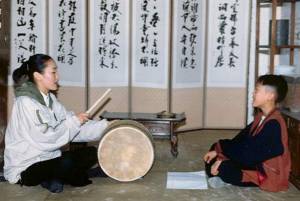The Convention is a permissive document and the majority of its articles are worded in nonprescriptive language, allowing governments to implement it flexibly. However, drawing up inventories is one of the specific obligations outlined in the Convention and in the Operational Directives for its implementation.
Inventories are integral to the safeguarding of intangible cultural heritage because they can raise awareness about intangible cultural heritage and its importance for individual and collective identities. The process of inventorying intangible cultural heritage and making those inventories accessible to the public can also encourage creativity and self-respect in the communities and individuals where expressions and practices of intangible cultural heritage originate. Inventories can also provide a basis for formulating concrete plans to safeguard the intangible cultural heritage concerned.

© Cultural Properties Administration of Korea
According to Article 11 of the Convention, each State Party is required to take the necessary measures to ensure the safeguarding of the intangible cultural heritage present in its territory and to include communities, groups and relevant NGOs in the identification and definition of elements of that intangible cultural heritage. Identification is a process of describing one or more specific elements of intangible cultural heritage in their own context and distinguishing them from others. This process of identifying and defining should lead to ‘inventorying’. Inventorying should be done ‘with a view to safeguarding’ – that is, inventorying is not an abstract exercise but an instrumental one. Therefore, if a certain number of elements of intangible cultural heritage have already been identified, States may decide to start implementing safeguarding projects for those elements.
Recognizing that States will take different approaches to inventorying, the Convention continues that States Parties are obliged to create one or more inventories of the intangible heritage present in their territory, and shall update them regularly (Article 12). While Articles 11 and 12 are more prescriptive than other Articles in the Convention, they still provide enough flexibility for a State Party to determine how it will prepare its inventories. States are free to create their inventories in their own fashion. However, intangible heritage elements should be well defined in the inventories to help put safeguarding measures into practice.
A State Party is not expected to have already drawn up one or more inventories before ratifying the Convention, although many have been doing so for many decades. On the contrary, the development and updating of inventories is an ongoing process that can never be finished. It is not necessary to have completed an inventory in order to start receiving assistance or filing nominations for the Lists of the Convention. However, the Operational Directives for implementing the Convention require that a State Party submitting a nomination file for inscription on either the Urgent Safeguarding List or the Representative List must demonstrate that the proposed element is already included in an inventory of the intangible cultural heritage present in its territory.
Since there are great differences among States concerning population, territories and distribution of intangible cultural heritage, as well as great diversity in their political and administrative structures, the Convention leaves each State Party a great deal of freedom to draw up inventories in ways best suited to its own situation, allowing national and local conditions and concerns to be taken into account.
Among the safeguarding measures enumerated in the Convention, research and documentation are likely to be among the first strategies that States will consider in order to understand ‘what is there’, ‘who does it’ and ‘why they do it’. States may wish to set up national intangible cultural heritage committees to coordinate this work, including relevant institutions, researchers and community representation, which will also facilitate interaction between members of communities and researchers.
States are able to choose whether to create a single, over-arching inventory or a set of smaller, more restricted ones. That is why neither the Convention nor the Operational Directives ever speak of ‘a national inventory’: instead, they refer to ‘one or more inventories’. In this way, States are not forced to include all domains or all communities within a single system. They may also incorporate existing registries and catalogues. A system that includes multiple inventories may be particularly appealing to federal states where responsibility for culture falls outside the remit of the central government, allowing sub-national regions or provinces to create their own inventories.
Some examples of ICH inventorying:
- The Bulgarian experience in inventorymaking
- The Brazilian experience in inventorymaking
- A four-year project to record living music and dance traditions in Ethiopia: towards a comprehensive national intangible cultural heritage inventory
- Community-based documentation contributes to the viability of intangible cultural heritage in the Philippines
- The Venezuelan experience in inventorymaking